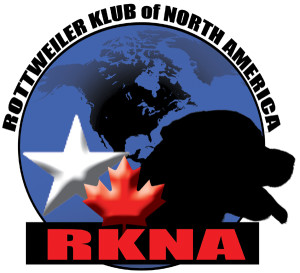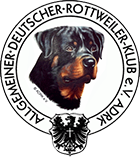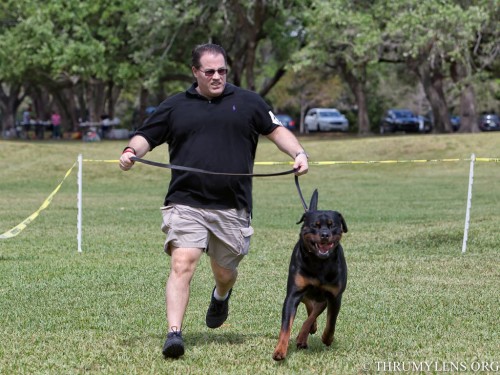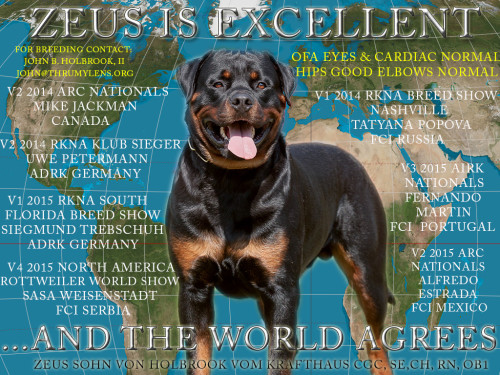 It’s very easy to forget (thanks to distracting glitter of shiny trophies and ribbons) that conformation style dog shows are about determining a dog’s suitability for breeding. The closer the dog conforms to the breed standard (and consequently the better it places in conformation style shows), the more suitable it is to be bred. In Germany, working breeds (like Rottweilers and German Shepherds) must meet certain requirements in order to receive a certificate for reproduction. Being “pretty” or simply conforming to the physical description of the breed standard isn’t enough. Dogs must also meet certain standards for temperament, working ability, and have certain health clearances. This is why people have the impression that “German Rottweilers” are magically better than US bred Rottweilers. It’s not that the Germans have figured out how to breed a better dog necessarily – it’s that only dogs which meet certain strict standards which are verifiable through testing are permitted to breed. Thus, the perpetuation of the desirable qualities outlined in the breed standard is ensured. In the US, the AKC does not have such requirements that have to be met in order to breed – if you have an AKC registered dog with “full” registration (as opposed to “limited”) then you can breed that dog to another AKC registered dog, and the litter produced would be eligible for AKC registration – regardless of factors like health, temperament, or conformity to the breed standard. However, organizations like Rottweiler Klub of North America (RKNA) have voluntary testing programs which owners and breeders can submit to which are quite similar to German testing standards. I’ve recently gone through the RKNA Standard Evaluation process successfully with my Rottweiler Zeus Sohn Von Holbrook Vom Krafthaus, so I thought I would document the process here on ThruMyLens, to encourage and help others to do the same.
It’s very easy to forget (thanks to distracting glitter of shiny trophies and ribbons) that conformation style dog shows are about determining a dog’s suitability for breeding. The closer the dog conforms to the breed standard (and consequently the better it places in conformation style shows), the more suitable it is to be bred. In Germany, working breeds (like Rottweilers and German Shepherds) must meet certain requirements in order to receive a certificate for reproduction. Being “pretty” or simply conforming to the physical description of the breed standard isn’t enough. Dogs must also meet certain standards for temperament, working ability, and have certain health clearances. This is why people have the impression that “German Rottweilers” are magically better than US bred Rottweilers. It’s not that the Germans have figured out how to breed a better dog necessarily – it’s that only dogs which meet certain strict standards which are verifiable through testing are permitted to breed. Thus, the perpetuation of the desirable qualities outlined in the breed standard is ensured. In the US, the AKC does not have such requirements that have to be met in order to breed – if you have an AKC registered dog with “full” registration (as opposed to “limited”) then you can breed that dog to another AKC registered dog, and the litter produced would be eligible for AKC registration – regardless of factors like health, temperament, or conformity to the breed standard. However, organizations like Rottweiler Klub of North America (RKNA) have voluntary testing programs which owners and breeders can submit to which are quite similar to German testing standards. I’ve recently gone through the RKNA Standard Evaluation process successfully with my Rottweiler Zeus Sohn Von Holbrook Vom Krafthaus, so I thought I would document the process here on ThruMyLens, to encourage and help others to do the same.
What is the RKNA Standard Evaluation or “SE”?
The RKNA “Standard Evaluation” is RKNA’s attempt to do German style breed suitability testing, but done in a very clever way. The German Rottweiler breed club (equivalent of the American Rottweiler Club) is called the ADRK (German Rottweiler Klub) and in order to be able to breed, a Rottweiler would have to pass an ADRK test called the Zuchttauglichkeitsprüfung or “ZTP” at a minimum.
Now, here’s the tricky part: In Germany, working ability in the working breeds is extremely important – and working ability is defined by a dog’s ability to perform in the European sport of IPO (formerly called Schutzhund). So one of the key components to the ZTP is for the tested dog to adequately perform in what is essentially the IPO level I protection routine (bite work). Now, RKNA recognized that the U.S. and Canada are both geographically larger countries than Germany, and IPO as a sport simply isn’t as prevalent in North America as it is in Germany. That means Rottweiler owners in North America, depending on where they live, may not have a good option to participate in IPO training. So an option was needed for Rottweilers in North America to determine breeding suitability that was not dependent upon the ability to train with an IPO club. The Standard Evaluation (or SE) is RKNA’s answer to this dilemma – the SE is essentially a ZTP test without the IPO I protection routine. According to RKNA President Susan Peyton, “the difference between SE and ZTP, would be the difference in US Marine and a Navy Seal. Both disciplines have the same foundation but the Seals have a higher standard under pressure.”
Technically speaking, the ZTP is the only true breed suitability test (which RKNA does offer as well) but at least with an SE, Rottweiler breeders and potential buyers can know the official measurements of their dog and know if a dog is free of disqualifying (DQ) faults and within FCI/ADRK breed standard for Rottweilers. Rottweilers can go through the SE testing process at most RKNA sanctioned Sieger shows which are held several times during the years in various locations. Rottweilers which successfully pass the SE are recognized by RKNA with the “SE” title which may appear after the dog’s name. While the test is completely voluntary, anyone who owns a Rottweiler in the U.S. or Canada they’d like to breed can and should complete the RKNA SE. In addition to earning the SE title, RKNA also awards 1 point toward that Rottweilers RKNA Champion (CH) title which is a great incentive for show dog owners to try and earn an SE.
What is Required to Participate in an RKNA Standard Evaluation (SE)?
Section 16d of the RKNA Policy Manual spells out the requirements necessary for a Rottweiler to have a Standard Evaluation Performed:
” The owner must provide a weight certificate signed by a vet within 20 days prior to the test. The dog must have a valid hip certification and have a tattoo or microchip for identification (handler is responsible for providing a microchip reader). The Rottweiler is assessed for conformation and soundness. The test includes everything on the dog being measured or evaluated, including: height at withers, body length, muzzle, chest depth, chest circumference, skull, eye color, bite and dentition, bone strength, head shape, cheek bone, and general behaviour. Original paperwork must be presented to Show Secretary upon registration at show. This includes registration papers and hip certification papers. If titles are to be recorded on the Standard Evaluation, proof of titles must be shown (score book and current membership card from organization the score book is held with, title certificates, etc.).”
Before a Rottweiler can even register for a Standard Evaluation, certain requirements must be met. The dog must have valid registration papers which are presented at the time of the SE. In my case, my dog is AKC registered, and I provided the original registration certificate. The dog must also have (at minimum) a valid hip certification from their country of registration. I submitted my dog for veterinary examination of his eyes, heart, hips, and elbows per Orthopedic Foundation for Animals standards (OFA does certifications for dogs registered in the US), and the results were sent to the OFA. In the case of the hips and elbows, the certification exam must be performed no earlier than two years of age. My dog turned two on May 1st, and I had his exam scheduled for May 5th. The RKNA event I planned to attend to have my Rottweiler’s SE performed was at the end of May, so I didn’t have much margin for error – it takes OFA about three weeks to issue an OFA number, which must be provided when registering for the SE. I also stopped by my vet a few days before the show and had my dog weighed, and they gave me a signed and dated confirmation of Zeus’s weight – 131 lbs. With my OFA certificates/numbers, my weight verification, and my binder with all of Zeus’s registration and title information, I had all the documentation necessary to both register for and pass the RKNA Standard Evaluation. However, some preparatory work with Zeus was necessary to ensure that he would successfully complete the Standard Evaluation.
Tatoo or Microchip?
One of the requirements for the SE is that the dog must have either an identifying tatoo or microchip and that the associated number must be verified as part of the SE. In my case, the judge scanned my dog’s microchip and verified its number with the Trial Secretary. Be sure and check with the club where you test regarding the availability of a microchip scanner – technically speaking, you should bring one with you. Microchip scanners are expensive so you might want to borrow one from a friend if possible.
Taking Measurements
The evaluating judge will take several measurements of your dog. Here are the measurements which were recorded for Zeus:
HEIGHT: 66cm
LENGTH: 73cm
CHEST DEPTH: 34cm
CHEST CIRCUMFERENCE: 96.5cm
SKULL: 15.5cm
MUZZLE LENGTH: 9cm
EYE COLOR: 2B (Dark to Medium eyes)
WEIGHT: 131lbs.
If you’d like to see how some of these numbers compare to the ADRK and AKC Rottweiler Breed Standard, click here.
During this phase of the evaluation, the judge will be using various measuring devices (wicket, tape measure, eye color chart, etc.) on your dog’s body, head, and face. You’ll want to prepare for this by making your dog comfortable with being touched and examined in this way. A good way to do this is to have other people (not the owner) touching the dogs face, holding objects up to and in front of the head, and wrapping a tape measure around the body. Provide treats and affirmation when the dog responds positively to reinforce this as a good experience for the dog.
The Critique
During this phase of the evaluation, the judge will perform a critique identical to how a judge would critique a dog in the Sieger show ring. The judge will examine teeth, check males for being intact, and generally feel up and down the dog. The judge will have the handler run a lap or two to show the dog’s movement, and will have the dog presented Sieger style (double handling using a handler and baiter). This part of the Standard Evaluation should be most familiar to both dog and handler since in all likelihood anyone trying to put an SE on their Rottweiler has previously shown the dog in a Sieger show.
Temperament Testing
For many, this will be the most challenging part of the Standard Evaluation. The dog and handler will be put through a series of exercises to test how the dog reacts in many different situations. Let me say up front that in my opinion the best way to prepare for the the SE temperament tests is to join an IPO club if possible. Many of the tests are based on what a dog would practice and perform when trialing for a BH, ZTP, or IPO I. I’m a member of the Southwest Ohio Schutzhund Club, and without being able to draw upon the experience and guidance of the club’s Training Director and members, we would not have had an ideal way to prepare for the SE temperament tests. Can you prepare a Rottweiler for the RKNA SE without being in an IPO club? Absolutely – again, the SE was created as an alternative to the ZTP because so many in North America don’t have easy access to an IPO club.
The first thing we were asked to do was to (on lead) walk the dog in and around a group of people (much like when you zig zag around people as part of a BH examination). The key here is that the dog must not react to or be distracted by the people in the group. Next we were asked to run down and back in the ring – while we did so, a starter pistol was fired (twice if memory serves). This was to test the dog’s reaction to gun fire (there should be none). Afterward, the group of people (there were I believe approximately 10) encircled Zeus and I, and pressed in very closely, then backed away. This was done twice – once with Zeus seated next to me, and once with him in a down position next to me. Finally, the group lined up on two sides facing one another, and Zeus and I had to walk through the center of the two groups. when we did so (twice) the judge had a 2 liter bottle filled with rocks, and shook the bottle as we passed. Again, the dog should not react to this as you go by. You’d need to have or buy your own starter pistol, and you’d need a lot of willing friends or neighbors available when you train…all just not very convenient, but certainly possible.
The below YouTube video is of a breed suitability test (they seem to call it a “breed survey”) which is quite similar to the RKNA SE and ZTP (in this test, the dog doesn’t actually have to run blinds as in a ZTP, but is challenged by a helper in a sleeve to apparently test the dogs self assurance). The video does a great job of showing the measurement taking phase, the critique, and the temperament testing which are all part of the RKNA SE:
Having earned Zeus’s SE title, I’m extremely proud of my dog, and more than a little proud of myself. This is a nice accomplishment for us, and makes me feel really good about using Zeus as a stud dog for breeding. We’re one point closer to Zeus’s RKNA CH title (he has 4 our of 5 points needed as of this writing), and we’re going to continue the work we’re doing with our local IPO club – we hope to trial for our BH in the Fall, and perhaps our IPO 1 in the Spring.






0 Comments
Trackbacks/Pingbacks